|
Swayfield
A reminder of past times greets the visitor to
Swayfield, seven miles north east of Bourne, in the shape of a beacon, once
used to light the countryside across the land to mark special occasions or to warn of
impending peril to the nation.
|
This modern reproduction bears the inscription
FIRE OVER ENGLAND
and was
erected on the 19th July 1988 to commemorate the 400th anniversary of the sighting of
the Spanish Armada. It is part of a national chain of beacons similar to that which was
used in 1588 to alert the local militia to the arrival of the invading fleet and was erected
by South Kesteven District Council with the help of villagers and of British
Telecom. |
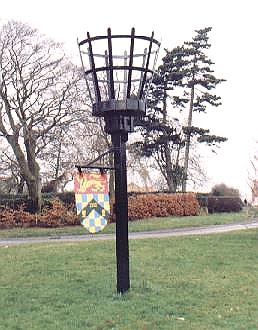 |
The name Swayfield is referred to as Suafeld in the Domesday Book
of 1086 and by 1202 had become Swauefeld meaning "the open
country with a track", from the Old English swęth and feld.
Nearby is all that remains of Lobthorpe, a large stone farmhouse and a
cottage or two, but here until the 18th century stood the seat of the
Sherards who were baronets and wealthy landowners. Lobthorpe Hall where
they lived has vanished together with all other traces of the family but
there are many grand monuments and memorials in marble surviving in the
parish church at North Witham, five miles to the east on the other side of
the Great North Road.
The church at Swayfield is dedicated to St Nicholas with a 13th
century battlemented tower and sits
surrounded by farm buildings on sloping ground a few hundred yards from the main
east coast railway line. The building is small and humble and largely rebuilt between 1875 and
1878 by
F H Goddard in the Early English style. The east window has nativity,
crucifixion and resurrection scenes, keeping green the memory of a 19th
century rector.
When I visted the village five years ago, I found both the
church and churchyard badly neglected and the fabric in need of serious
attention but in the intervening years there has been a drastic change and
today it is a joy to see. Much work has been done to the building and its
surrounds and the church is now one of the neatest in the district with
newly mown grass and gravestones kept in trim while those that have
toppled have been neatly placed underneath trees and around the perimeter.
This church is now well worth a visit.
 |
|
Swayfield church in April 1998 (above) and again
in April 2003.
|
|
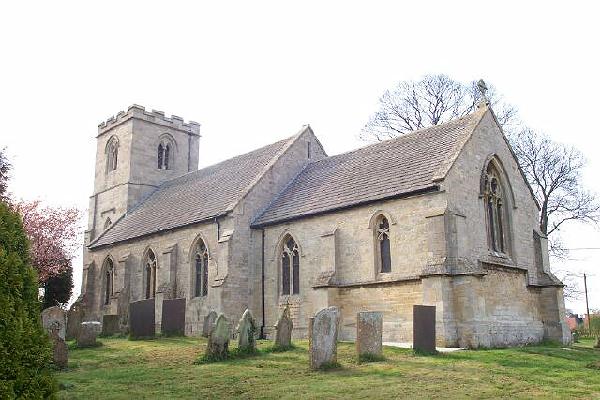 |
The Royal Oak Inn at Swayfield is reputed to date back to the 17th century, or at least
parts of it do, because the building has been greatly extended at various
times with additions at the front and side. One attractive feature is the
swinging sign outside with a picture remembering Charles II (1660-1685)
who has more inn signs to his memory than any other monarch. When his army
was routed at the Battle of Worcester in 1651, Charles escaped the field
with a £1,000 reward offered for his capture and his many escapes before
finally embarking for France included hiding in an oak tree, an event that
was commemorated for centuries by Oak Apply Day. This is rarely remembered
today although hundreds of Royal Oak public houses survive.
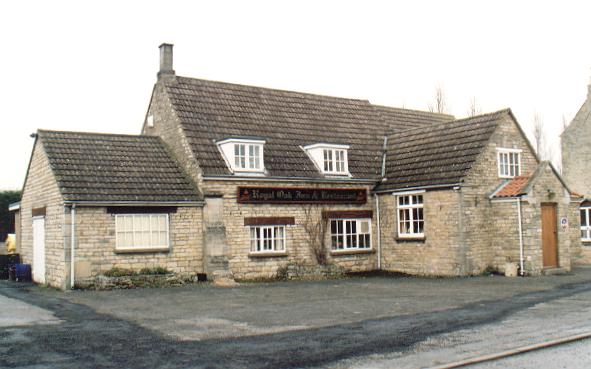
The old school at Swayfield, as with so many of the 19th century schools in country areas,
is no longer a seat of learning for village children and has been converted for another
use, in this case as a private home. A stone plaque on the side wall announces that it was "Erected by the Trustees of
Browne's Hospital in Stamford A D 1867" while a second plaque on the front indicates
that it was restored in 1982.
It is most commendable that these old properties should be
refurbished for continual use but how misguided of this owner to hide such an attractive
building behind a leylandi hedge that even obscures the original Victorian iron railings.
They should follow the example of the owners of the School House, built next door for
the village schoolmaster and his family, who have kept alterations to a minimum and left
the front aspect of the building open for all to see and enjoy.
Cottages originally built for farm labourers abound in the villages around Bourne, some
erected by the local landowner and others by the old rural district council when wealthy
and influential farmers sat on the council and ensured that decisions for such
developments were made in their favour.
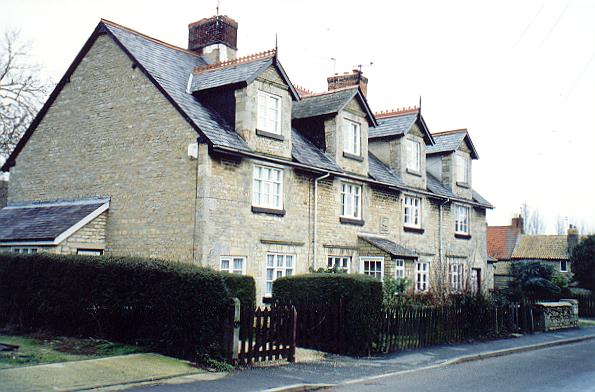
There are few villages today without a row of houses originally intended for agricultural
or estate workers, built in stone or red brick, although many are now tenanted by private owners
or couples from the housing waiting list, because farm workers are no longer in such
great demand and a tied cottage or council house would be little temptation for them to
accept such employment.
Many have been sold off to sitting tenants in this age of owner-occupiers and extensions
and additions to this terrace of four houses at Swayfield, built in 1868, indicate that
there are at least two private owners who have put their own individual stamp on the
properties.
A new village hall has recently been built at Swayfield at a cost of £126,000 to
mark the new millennium. The old village hall for the past fifty years was an ex-army
corrugated iron-clad hut that stood on the same site and was demolished before
construction work began but its replacement is much bigger with modem facilities for
communal events including a kitchen, a committee room and toilets and, later on,
perhaps a stage for theatrical productions with lighting and a sound system.
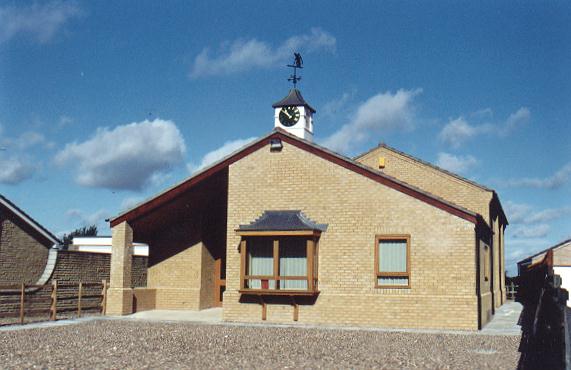
Contributions towards the cost have come from the local authorities and various other
organisations but the village had to raise 10 per cent of the total and among their fund
raising efforts were fetes, quiz nights, raffles, bring-and-buy sales and a buy-a-brick
scheme at £10 apiece and each buyer is being recorded for posterity. This community
participation is a test of the strength of village life today and the success of this building
venture should augur well for the hall's enduring appeal for community events in the
future.
Among the donors were the Carnegie United Kingdom Trust which gave £1,000 to
provide carpets and equipment for indoor bowling which is to become a weekly activity.
The trust has donated more than £32,000 since 1991 to update facilities at village and
community halls around the country, mainly for new activities and services that will
benefit the entire community. The new hall was officially opened in
September 1999 by the High Sheriff of Lincolnshire Mr Francis Dymoke.
REVISED APRIL 2003
See also
Strange
but True

Go to:
Main Index Villages
Index
|





